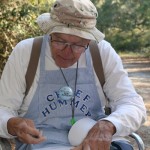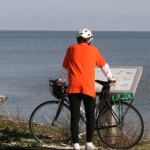Even birds love our byway. Alabama’s Coastal Connection is located in the Mississippi Flyway, a migratory route followed by neotropical birds that winter in the tropics and return to their northern homes in the spring. For several years the Hummer Bird Study Group has set up a research station at Fort Morgan each spring and fall. Their mission is to learn more about the birds and their patterns.
A description of the session reads: “The Alabama Gulf Coast is a critical stopover point as migratory birds return from Central and South America. Banding hours are from before dawn to mid-afternoon, depending on the flow of birds. Bring a lawn chair, binoculars and inquisitive mind . . . “
I went to the site today with my inquisitive mind and my camera and alas, as is the case during the most beautiful mornings, the birds were few. I learned that with good weather many birds can keep flying, even after their 48-hour journey across the Gulf of Mexico. One researcher told me birds don’t get tired like people do, they operate more like cars, going until they run out of gas. I guess they get better mileage in good weather, when they don’t have to fight wind or rain.
 I met Bob Sargent, the leader of the Birmingham, Alabama based research group; Chief Hummer, according to his apron. He’s a little like a rock star to the birding enthusiasts who visit the site. He’s also one of the nicest people you’ll ever meet. While I was there he signed copies of his book about Hummingbirds for folks, described the group’s work to others and engaged in thoughtful discussions about the relationship of habitat loss to species’ sustainability.
I met Bob Sargent, the leader of the Birmingham, Alabama based research group; Chief Hummer, according to his apron. He’s a little like a rock star to the birding enthusiasts who visit the site. He’s also one of the nicest people you’ll ever meet. While I was there he signed copies of his book about Hummingbirds for folks, described the group’s work to others and engaged in thoughtful discussions about the relationship of habitat loss to species’ sustainability.
Through sessions like these, open to the public, novice and experienced birders alike, he is broadening support for our wildlife and our habitats. He is helping people recognize that they, too, are a part of the complex puzzle of coastal biodiversity.
 I was proud to see one of our new interpretive signs at the site. About 30 signs describing the waters, ways and wildlife of the byway have been placed all along the route through a partnership with the Wolf Bay Watershed Watch funded by the Mobile Bay National Estuary Program. This one describes migratory birds. Other topics along the way include Coastal Birds, Marine Mammals and Bog Plants. On the way back from the site, I stopped and talked to a visiting bicyclist who was enjoying one of the interpretive signs on Fort Morgan Road about Alabama’s Coastal Birding Trail, which shares some of the byway route.
I was proud to see one of our new interpretive signs at the site. About 30 signs describing the waters, ways and wildlife of the byway have been placed all along the route through a partnership with the Wolf Bay Watershed Watch funded by the Mobile Bay National Estuary Program. This one describes migratory birds. Other topics along the way include Coastal Birds, Marine Mammals and Bog Plants. On the way back from the site, I stopped and talked to a visiting bicyclist who was enjoying one of the interpretive signs on Fort Morgan Road about Alabama’s Coastal Birding Trail, which shares some of the byway route.
 Look for these and other interpretive signs as you travel the byway. And if you’re here in spring or fall, be sure to check the calendar of events to see if you can catch a bird banding session. If you’re a birder, that’s just one of the reasons you’ll love our byway. If you’re not, like me, you might just learn something new. You might even make friends with a rock star.
Look for these and other interpretive signs as you travel the byway. And if you’re here in spring or fall, be sure to check the calendar of events to see if you can catch a bird banding session. If you’re a birder, that’s just one of the reasons you’ll love our byway. If you’re not, like me, you might just learn something new. You might even make friends with a rock star.
Bob Sargent might be from “up north” in Birmingham, Alabama but we’ll surely adopt him as one of our many coastal characters who love our resources and are helping promote, preserve and protect them. That makes him a rock star in my book. I bet the birds would agree.



Leave A Comment